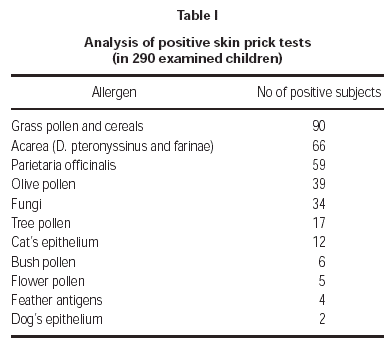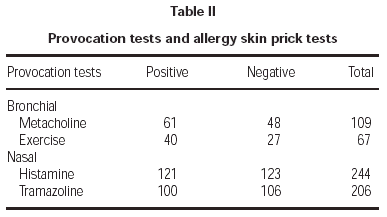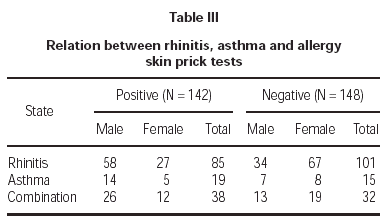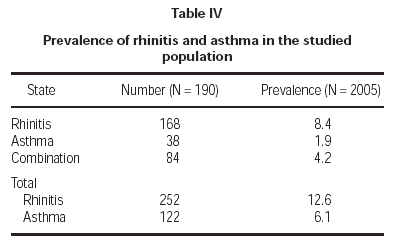INTRODUCTION
Allergic rhinitis, asthma and atopic eczema are included in the most common chronic diseases. Indeed, they present an increasing prevalence rate over the last years1. In Sweden, for example, the number of children suffering from rhinitis, asthma or eczema has almost doubled over the last 12 years2. Recent studies show that prevalence of asthma ranges between 5.8 % to 7.2 % in the USA3. The results of the long-lasting international study on asthma and allergic disease in children (ISAAC) conducted in school-age children in 155 research centers in 56 countries showed significant differences related to the prevalence of asthma in different countries4, that may be due to environmental factors. In this study the prevalence of asthma in children from Athens aged 6-7 years reached 7.6 %, whereas according to relatively recent studies from Thessaloniki ranges between 6.2 %-10.2 %5,6. Data collection so as results induction for these studies on children were based only on written answers of the parents given in questionnaires. This fact could alter the results since parents, usually, do not consider their children as "asthmatic", if they are not under antiasthmatic treatment7.
The aim of this study was to define the prevalence of asthma and allergic rhinitis in children aged 9-12 years from the region of Thessaloniki, with the use of normal measurements after the collection and analysis of the answers given in questionnaires.
MATERIAL AND METHODS
Subjects
In the study conducted during the school year 2001-2002 participated 2005 children of the last three grades of all the primary schools of the Polichni Municipality, 7 km NW to the center of Thessaloniki.
Questionnaire
The parents filled in a detection-specific questionnaire for respiratory diseases during childhood, based on the Ferris questionnaire8, with some additions concerning symptomatology from the upper respiratory system. The adequacy of the questionnaire has been proved in previous epidemiologic studies on children9. It contains questions about demographic data of the children, educational level of the parents, living conditions at home, domestic pollution factors (smoking habits, power used for heating and cooking), any respiratory diseases of the family members and the presence of pets. The history and symptomatology of the children of the upper and lower respiratory system so as any allergic reactions and history of infectious diseases of childhood are investigated through adequate questions. A number of two thousand one hundred and thirty three questionnaires were distributed to children and, under guidance, they were filled in by the parents and collected a week later (2050 questionnaires, participation 94 %).
Out of 493 children who gave positive answers to the questions about allergies, asthma and rhinitis, 89 were excluded after a detailed history (personal interview with the parents). Another 35 children were excluded, since no atopic background was found (total lgE < 50 UI)10. Out of the other 369 atopic children, 65 presented atopic dermatitis only, whereas 14 suffered from drug allergy. The other 290 atopic children presented chronic respiratory symptoms, i.e. wheezing, dyspnea, persistent relapsing cough or nasal symptoms (sneezing, itching, catarrh and nasal obstruction) of non-infectious origin and were considered as suitable for further examination.
Skin prick tests
The skin prick tests were performed with the use of the standard technique with 11 common allergen solutions (flower, tree, bush, cereal and grass pollen, olive pollen, parietaria officinalis, acarea-d. pteronyssinus and farinae, fungus antigens, cat's and dog's hair and feather antigens). For the "reading" of the results the blister diameter was compared with these of the normal saline and histamine solutions. As positive were characterized, when the blister diameter of the allergen was higher that this of histamine11.
Provocation tests with methacholine and exercise test
The provocation test with metacholine for the determination of bronchial hypereactivity was conducted with the consecutive administration of solutions increasing the substance density, aerosolized by a DeVilbiss nebulizer connected to a dosimeter, with the method of five total inhalations as described by Chai et al12. Spirometry measurements were performed with a dry Vitalograph Ltd spirometer (Buckingham, England). The test was considered as positive, when FEV decreased by 20 % with < 8mg/ml metacholine concentration.
The exercise test was performed on a treadmill for 6 minutes under work conditions ensuring a maximum fatigue under a stable temperature and humidity, with the use of the method as described by Godfrey et al13. It is known that the fatigue test is a reliable alternative provocation test for the measurement of bronchial hyper-reactivity in children14. The fatigue test was performed during a period of stable clinical state and on a different day from the metacholine test. It was considered as positive, when 6 minutes after test completion, a decrease of maximum expiratory flow about 20 % was being recorded.
Nasal provocation test with histamine and "rhinodilation" with tramazoline
For the investigation of rhinitis, we studied the nasal reaction during nasal provocation with histamine solution and that after the administration of a local decongestant drug (tramazoline). The response to the nasal provocation was measured with the anterior rhinomanometry method15 as a decrease (after histamine inhalation) or as an increase (after tramazoline administration) of nasal flows. A Rhinotest mP500 rhinomanometer (Allergopharma Joachim Ganzer KG, Germany) was used. The nasal resistances were calculated from the measurement of flows with intranasal pressure 150 Pascal per nostril and they were expressed in cm3/sec. The provocation tests were applied to the nostril with the highest flow. Before provocation tests, normal serum was inhaled followed by the test 10' later. For the nasal provocation test two histamine solutions 15 μg and 75 μg respectively were used, whereas for the "rhinodilation" test one tramazoline inhalation was administered. A 40 % variation from the baseline was considered as a positive response to nasal provocation16. Tests were performed in two consecutive days.
Definitions
Bronchial asthma was defined as the presence of chronic respiratory symptoms (wheezing, dyspnea, persistent relapsing cough) and with a positive non specific provocation test with metacholine or exercise test or both.
Rhinitis was defined as the presence of chronic nasal symptoms (sneezing, itching, catarrh and nasal obstruction) and with a positive non specific nasal provocation test with histamine or rhinodilation test with tramazoline or both.
Statistical analysis
For the statistical analysis of the results the x2 test was used.
RESULTS AND DISCUSSION
The results of skin prick tests are presented in table I. Table II presents the results of bronchial and nasal provocation tests according to the results of prick tests.
The metacholine provocation test was positive in 109 children, whereas the exercise test on treadmill in 67. The histamine nasal provocation test and the "rhinodilation test" with tramazoline were positive in 244 and 206 children, respectively.
The prevalence of rhinitis, asthma and the combination of asthma and rhinitis according to sex and the prick test results are shown in table III. In 142 children (98 boys and 44 girls) were found positive skin prick tests, whereas in the other 148 negative (54 boys and 94 girls). The difference of frequency in positive tests between boys and girls was statistically significant (p < 0.001) so as the difference of frequency in negative tests.
One hundred sixty eight children suffered from rhinitis, 38 from asthma and 84 from both rhinitis and asthma (table IV).
The prevalence of asthma in the total population was 6.1 %, whereas that of rhinitis 12.6 %. Only 37 % of the parents of asthmatic children knew that their children suffered from asthma, while even fewer (32 %) knew that their children suffered from rhinitis.
According to the results of the study, the prevalence of asthma in the total children population was 6.1 %. The comparison with data from other countries is useless, due to the wide range of asthma prevalence in children of different countries, as also confirmed by the recent multi-centric ISAAC study4. Based on this study the prevalence of asthma in Greece is 7.6 % at the age of 6-7 years and 3.7 % at the age of 13-14 years. Our country participates in this recent study with only one center, while other western European countries participate with 2 to 15 research centers. This could only lead to an uncertain comparison with the results of this study. In all cases it seems that our findings do not differ from these of the industrial countries, like the USA3, where the respective rates range between 5.8 and 7.2 %. Differences compared to other studies concerning the area of Northern Greece6 are most possibly due to a different research methodology. In a study of 10781 children conducted with the use of questionnaires only in five cities of Northern Greece, the prevalence of asthma was 5.7 % in total and ranged between 4.2 % to 6.2 %17.
Several patients suffering, according to their doctor, from asthma deny it. In a study conducted in 4 different countries only 50 % of the subjects who according to their doctor suffered from asthma reported it in the questionnaire18. On the other hand, when only questionnaires are used subjects with insignificant clinical symptoms19 may be considered as asthmatic. This was avoided here after a personal interview with the parents in order to obtain a detailed history of those children, who gave positive answers to the questions concerning asthma and rhinitis symptoms. It is interesting to see how real is the prevalence of asthma reflected in the results of any study, particularly when the issue is whether it is increasing or not20.
Indeed, according to several well-organised studies, the prevalence of asthma increases worldwide over the last decades in children and young adults by 5-6 % annually21. This trend is not confirmed by the findings of this study, when compared with those of a previous research of our Laboratory in a similar population from the same region5, with a prevalence of asthma reaching 6.2 % in Thessaloniki. Likewise, in a Finnish study in 11500 adults22, an increased prevalence of asthma from 1982 until 1990 was not found. The observed international increase of asthma prevalence has not yet been completely explained. The main factors responsible for this are the different environmental living conditions (air pollution-environmental and domestic) and the viral infections due to the intensive gathering in kindergartens23. It seems that the above conditions have not changed significantly in the studied areas, which may explain the stable asthma prevalence over the last years.
The prevalence of rhinitis has not been studied within such a wide range, as this of asthma. Based on this study, it was found that it reaches 12.6 %. In a previous study conducted by the Laboratory of Physics of the Atmosphere, with the use of questionnaires only, in 10781 children in five cities of Northern Greece, the prevalence of rhinitis ranged between 20.8 % and 33.4 %. According to the first results of the ISAAC study, the prevalence of rhinitis in children of the Scandinavian and northeastern European countries aged 6-7 years ranges between 6.1 % and 25.7 %, whereas in children aged 13-14 years between 8.8 % and 45.5 % depending on the country24. It seems that the prevalence of allergic disorders increases according to the growth level of each country.
According to the findings of this study, it is concluded that the results of non specific provocation tests do not comply with those of skin prick tests. It is known that the atopic state and the bronchial hyper-reactivity have different pathogenetic mechanism. The presence of positive skin prick tests does not mean necessarily presence of clinical allergic disease nor the presence of bronchial hyperreactivity can differentiate safely the asthmatic from the non asthmatic children25. The great number of children with rhinitis or asthma and negative skin prick tests could be due either to allergy to antigens which were not included in the applied prick tests or to the presence of intrinsic asthma or non allergic rhinitis.
It is also interesting that only a few parents of the asthmatic children and even fewer of those with rhinitis were aware of their children's health problems. This means that the above diseases during childhood are underdiagnosed and thus undertreated affecting children's health.
In conclusion, the prevalence of asthma and rhinitis was 6.1 % and 12.6 % respectively among the examined children. Both asthma alone and the combination of rhinitis and asthma were more frequent in boys than in girls. The atopy (positive prick tests) was also more frequent in boys. A significant number of children with positive non specific provocation tests had negative skin tests. We consider that the use, apart from questionnaires, both of the clinical evaluation and the standard methods (bronchial and nasal provocation tests) for the diagnosis of asthma and rhinitis represents more accurately the prevalence in children population.












